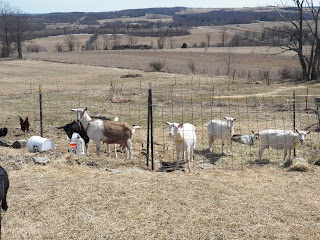Cheese making is in my future. Of that, I can say more confidently now. I tasted my first "aged" goat cheese a couple nights ago and it was love at first bite. I went a little crazy in the gourmet cheese section of Wegmans and purchased three kinds, actually:
Humboldt Fog, which is an aged tangy, moldy bleu type cheese,
Garrotxa, similar to Romano or Asiago I would say, and a
Sweet Vanilla Cardona Cheese, which was the mildest and had a faint buttery vanilla flavor. Yummm, all three. My favorite was the bold Humboldt Fog. Worth each and every of the $6 I paid for the small wedge. Anyway, I came away quite excited. See, I love our raw, fresh goat's milk. And I love the farmer's cheese I make from our goat's milk. But I just haven't cared much for any of the Chevre's (soft, fresh, cultured goat's cheese) I've tried. Too goaty. Yes, I just said that. And since the idea of becoming a semi-serious cheese maker has been kicking around in the back of my mind, and since I bought this book:
Mastering Artisan Cheesemaking, The Ultimate Guide for Home-Scale and Market Producers
by Gianaclis Caldwell
and have drooled over the pages, I figured I better discover whether I even like the stuff or not. Are ya with me?
And I do.
I even chose them over the dark chocolate cake that night. And happily! Gasp! I have hidden what's left in a corner of the fridge so that it's all mine. And I really like to spoil my children with good food. But I just love this cheese too much. It's mine. I've had so many requests for cheese that now I've ordered the cultures and it's time to start learning, darn-it. And now I know I'll like it. And I'll even play around with different Chevre recipes too, cause I really want to like that.
But I'm getting ahead of myself. For the last few years,
this recipe has been my old standby solution for the Spring and Summer
too much milk in the fridge need space now (!), dilemma. Well, this and yogurt, and ice cream. But I'll save those for another day. This cheese is yummy. And
really easy. And the good news for you, readers, is that you can be a cheese maker too. Use any milk you want! Just not ultra-pasteurized. It won't form a good curd. Here's the recipe if you wanna give it a go :)
Ingredients: 1 gallon whole milk, 1/3-1/2 cup vinegar or lemon juice (I like vinegar results better), and salt.
That's it!
Let's make cheese:
Heat your milk (slowly, while stirring frequently) to 190 degrees F. The milk should just be starting to really bubble/foam up.
Do not bring it to a full boil. Remove your milk from the heat and SLOWLY stir in your acid (vinegar or lemon juice). Don't overstir. You should notice the white curds start to separate from the yellow-ish whey. Cool. Let it sit (don't stir here) for about 20 minutes until you really have good separation. Then ladle your curds into a cheesecloth (or muslin, or even pillowcase) lined colander. Let drain there for a few minutes, then add salt to taste, gather the ends of your cheesecloth at the top and tie together and hang your sack of cheese to drain ( I use a long wooden spoon handle over a pot) for 10 minutes to a couple hours. Depends on how firm you want your cheese. We
like to eat it tend to devour it while it's still warm, so it never gets hung long!
Man, it's good warm! At this point you can refrigerate it for a week or so. Some say the taste improves after a day or two in the refrigerator. But I like it fresh! This cheese doesn't melt well, but is great in salads, on sandwiches, and even chunky on pizza or focaccia. If it makes it past your kitchen counter, that is.
 |
| Ladling the curds |
 |
| This is not my picture. But I love the simple-ness of it. Though I can't help thinking, "what did the poor cheese do!?" Does it not look like a hanging? Lol. |
 |
| Our finished product. |
Have fun!
Elizabeth






.JPG)




















